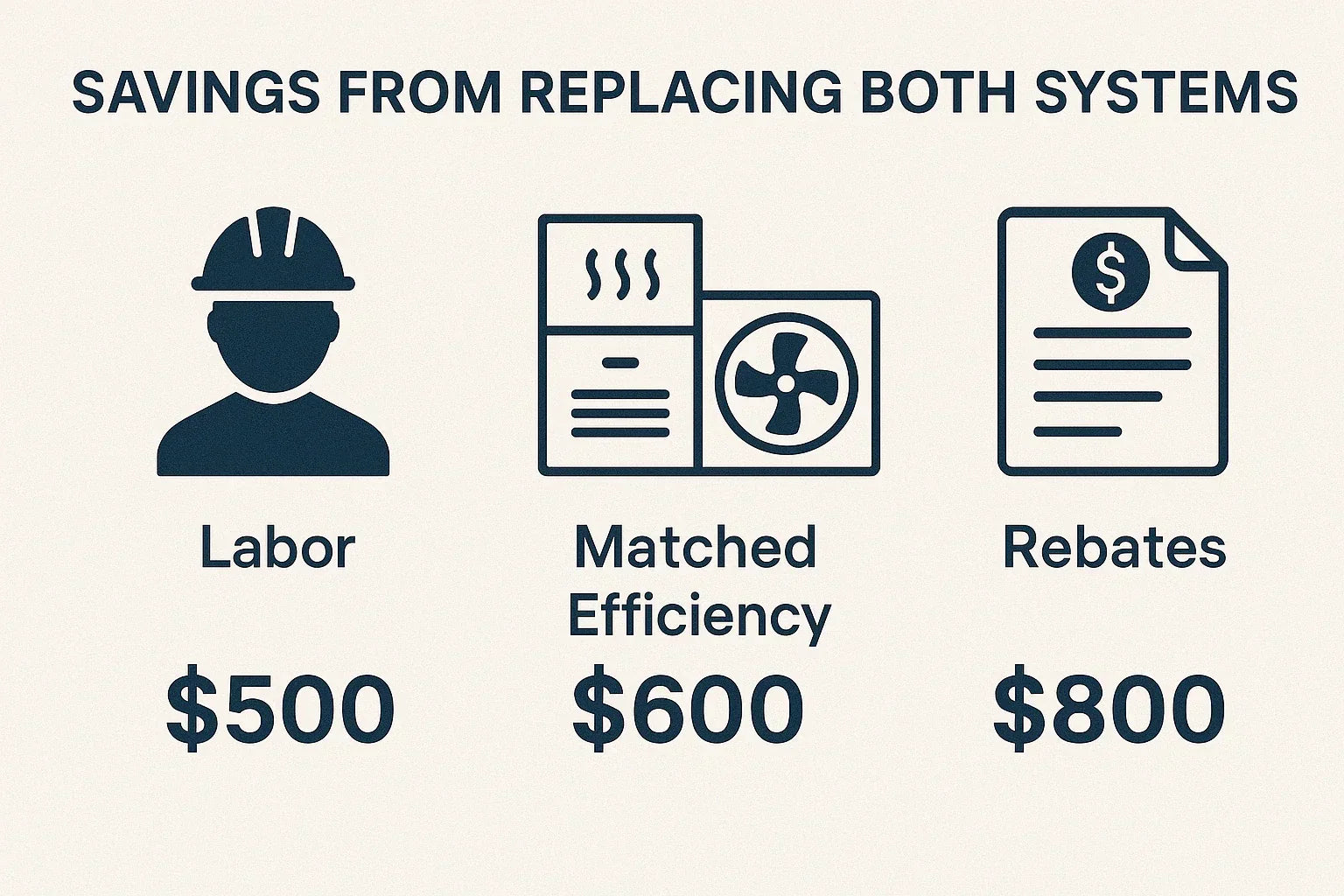If your furnace is on its last legs and your AC is starting to show its age, you might be wondering whether replacing them both at the same time is worth it.
While the price tag for a combined replacement can look steep, bundling the work often makes financial sense. It can save you on labor costs, improve system performance, and help you qualify for rebates or incentives that aren’t available when replacing one system at a time.
In this guide, we’ll cover average 2025 pricing, cost breakdowns, when it makes sense to bundle replacements, and how to save without cutting corners.
📘 If you haven’t already, start with How Much Does a New Furnace Cost? to understand the furnace portion of your budget before adding the AC to the equation.
Average Cost to Replace a Furnace and AC Together in 2025
On average, replacing both your furnace and central AC system together in 2025 costs $8,500–$17,500, installed.
Your price will depend on:
-
Home size (larger homes require higher-capacity systems)
-
Efficiency ratings (standard vs. high-efficiency models)
-
Brand and features (variable-speed blowers, modulating furnaces, multi-stage compressors)
-
Installation complexity (ductwork, venting, electrical upgrades)
According to ENERGY STAR’s Central Air Conditioners and Furnaces guide, high-efficiency systems can reduce your energy use by 20% or more compared to older, less efficient models.
Furnace and AC Cost Breakdown
When you get a combined replacement quote, it should detail the separate equipment and labor costs for each system.
Equipment Costs
-
Standard Furnace (80% AFUE): $4,500–$6,500 installed individually.
-
High-Efficiency Furnace (95–99% AFUE): $6,000–$9,500 installed individually.
-
Standard AC (14.3 SEER2): $4,000–$6,500 installed individually.
-
High-Efficiency AC (18+ SEER2): $5,500–$8,500 installed individually.
Bundling typically brings the combined total down by $1,000–$2,000 compared to replacing them separately.
Labor Costs
Labor can make up 30–50% of your total bill. Installing both systems at once saves on:
-
Crew mobilization (one trip instead of two)
-
Shared ductwork modifications
-
Electrical and gas line adjustments done in one session
The ACCA’s HVAC Installation Best Practices highlight that a properly planned full-system replacement can streamline installation without sacrificing quality.
Additional Costs
Be prepared for potential extras, such as:
-
Ductwork repairs or replacements – Old or leaky ducts can undermine your new system’s performance.
-
Electrical upgrades – Adding dedicated circuits or breaker panel upgrades.
-
Permit fees – Varies by city but typically $100–$500.
-
Smart thermostat installation – Often bundled for $200–$500.
Why Replacing Both Systems Together Can Save Money
Lower Labor Costs
Doing both systems in one project reduces total labor hours by 15–25%, which can mean hundreds or even thousands in savings.
Matched System Performance
Furnaces and AC units share the same blower motor. Replacing both ensures:
-
Components are properly matched for airflow and efficiency.
-
You avoid compatibility issues that can reduce system lifespan.
Fewer Disruptions
Instead of having two separate installation days (and two sets of home disruptions), you’ll have one.
According to the DOE’s Heating and Cooling Upgrades guide, matching equipment also maximizes the efficiency of your HVAC system, which helps you save on energy costs long-term.
When It Makes Sense to Replace Both
1. Both Systems Are Near the End of Their Lifespan
-
Furnaces typically last 15–20 years.
-
AC units typically last 10–15 years.
If both are nearing these ages, replacing them together prevents back-to-back installation bills.
2. You Want a High-Efficiency Upgrade
High-efficiency furnaces (95%+ AFUE) and AC units (18+ SEER2) deliver lower energy bills and may qualify for significant rebates.
3. Rebates and Incentives Are Available
Some utility companies and state programs offer larger incentives for bundled replacements. The Database of State Incentives for Renewables & Efficiency (DSIRE) is the best place to check available offers in your area.
4. You’re Financing Your HVAC Replacement
If you’re already financing one unit, rolling both into the same loan may keep your payments manageable without doubling your interest costs.
Tips for Getting the Best Price
Get Multiple Bids
Ask at least three licensed HVAC contractors for written, itemized bids. This helps you compare both cost and what’s included.
Compare Total Installed Cost
Don’t just look at the equipment price — labor, permits, and extras can vary significantly between contractors.
Time Your Installation
Spring and fall are typically “off-season” for HVAC work, meaning you may get lower labor rates and better availability.
Leverage Rebates and Tax Credits
Stacking incentives with manufacturer promotions can cut $1,000–$3,000 off your total cost.
Final Thoughts – Bundling for Long-Term Savings
Replacing your furnace and AC together in 2025 might feel like a big hit to your budget, but the long-term savings and convenience often outweigh the initial cost. You’ll benefit from:
-
Lower combined labor costs
-
Matched performance and efficiency
-
Fewer future disruptions
-
Potential for larger rebates
If both systems are aging or you’re planning a high-efficiency upgrade, bundling them into one project could be the smartest move you make for your home’s comfort — and your wallet.
📘 Next read: Furnace Cost Differences by Fuel Type: Propane, Oil, Natural Gas, Electric to see how your fuel source impacts both equipment costs and operating expenses.
Alex Lane
Your Home Comfort Advocate







